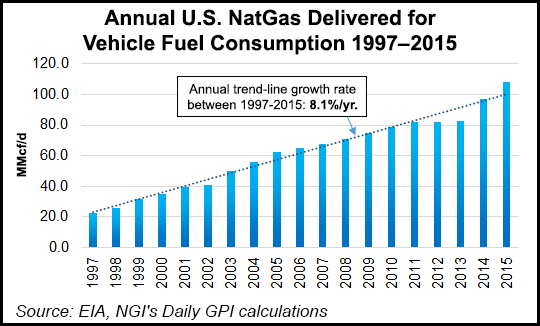Infrastructure | NGI All News Access
Production of Near-Zero Emission NGV Engine Begins
Alternative transportation manufacturer Cummins Westport Inc. has begun production of the near-zero (NZ) variant of the 8.9-liter ISL G natural gas vehicle (NGV) engine in Rocky Mount, NC. The NZ engine was first certified a year ago (see Daily GPI, Oct. 8, 2015).

Emissions from the engines are 90% lower than current U.S. Environmental Protection Agency (EPA) and California Air Resources Board (CARB) standards. They are certified to California’s optional standard of 0.02 grams of nitrogen oxide/brake hp/hour.
California Energy Commission staff has designated the NZ natural gas engines as “commercially available” in a draft 2017-18 investment plan update, stating that with the use of biomethane or renewable natural gas fuels the advanced NGV engines can “reduce the lifecycle emissions of medium- and heavy-duty vehicles to levels near or equal to those of zero emission electric vehicles [see Daily GPI, May 6].”
At the North Carolina engine manufacturing plant, the ISL G NZ is available as a first-fit engine with transit, shuttle, school bus, refuse truck and truck original equipment manufacturers, or it can be an engine replacement (repower) for existing ISL G vehicles, Cummins Westport said.
Reliability and operating improvements have been made on the base ISL G engine while keeping the NZ version “at the forefront of cost-effective and dependable emission reduction strategies in transit, medium-duty truck and refuse applications,” said Cummins Westport President Rob Neitzke.
Neitzke called the new engines “a game-changing solution for the reduction of urban tailpipe and engine-related emissions.”
The engine announcement came at the same time California Gov. Jerry Brown was unveiling that state’s zero-emission vehicle (ZEV) plan, which is aimed at building the ZEV transportation market statewide by removing barriers and ensuring transition benefits.
At this point, the state plan does not include the NZ NGVs, setting a goal of 1.5 million hydrogen, fuel cell and fully battery electric vehicles (EV) by 2025. California’s plan is focused on medium- and heavy-duty vehicles, as well as ZEV technologies in public transit and freight transport, Brown said.
The state plan recognizes that the long-term light-duty ZEVs eventually must be the focus of any comprehensive transportation electrification, which is the ultimate goal. “The state’s transportation and climate goals require a broad, multi-modal approach to transportation electrification beyond individual passenger vehicles,” a state spokesperson said.
California’s plan outlines six broad goals for the state government in advancing ZEV development:
Separately, Southern California-based Clean Energy Fuels Corp. took more liquefied natural gas (LNG) fueling to the Pacific Northwest, opening a new public fueling station along Interstate Highway 5 in the Tacoma, WA, suburb of Fife. It is another link in Clean Energy’s self-described “America’s Natural Gas Highway” that was unveiled four years ago (see Daily GPI, Aug. 25, 2011).
Clean Energy designed, built and will operate the LNG station along 20th Street, East, in Fife. The station will have two LNG fast-fill pumps and will be open 24/7 to the general public and fleets. Tacoma-based Interstate Distributor Co. will use the facility for its LNG tractor-trailers that operate in the Northwest.
Last month, Clean Energy opened a public NGV fueling station in Central Point, OR, helping solidify West Coast linkage between California and Washington state.
Interstate Distributor was the first national freight carrier in the Pacific Northwest to switch to natural gas for its fleet operations, so CEO Marc Rogers said he was glad to see another NGV fueling station in the region. “We made the transition to natural gas early so we would be ahead of the game, and now the infrastructure is here.”
© 2024 Natural Gas Intelligence. All rights reserved.
ISSN © 1532-1231 | ISSN © 2577-9877 |
